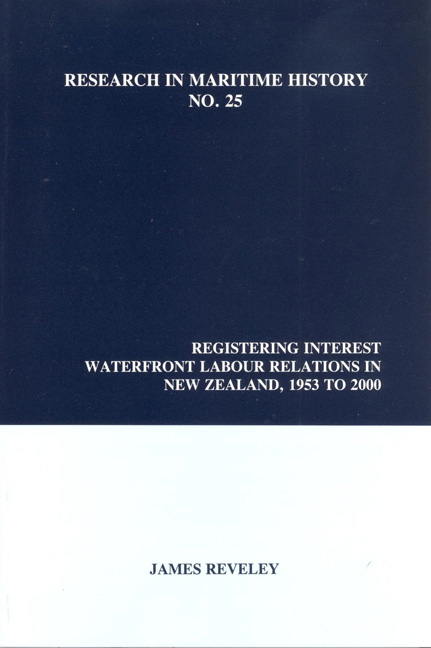Book contents
- Frontmatter
- Contents
- About the Author
- List of Figures
- List of Tables
- Acknowledgments
- Introduction
- Chapter 1 Unions and the Bureau System
- Chapter 2 The Waterfront Employers: Companies and Coordination Mechanisms
- Chapter 3 Labour Relations in the Conventional Cargo Era
- Chapter 4 Negotiating Technological Change
- Chapter 5 Labour Relations after Containerisation
- Chapter 6 Waterfront Labour Reform
- Conclusion
Introduction
- Frontmatter
- Contents
- About the Author
- List of Figures
- List of Tables
- Acknowledgments
- Introduction
- Chapter 1 Unions and the Bureau System
- Chapter 2 The Waterfront Employers: Companies and Coordination Mechanisms
- Chapter 3 Labour Relations in the Conventional Cargo Era
- Chapter 4 Negotiating Technological Change
- Chapter 5 Labour Relations after Containerisation
- Chapter 6 Waterfront Labour Reform
- Conclusion
Summary
Even to observers with only a passing familiarity with New Zealand's maritime history, events in the country's ports in 1951 and 2001 reflect a striking similarity. In each year there was a long-running waterfront dispute that involved the registration of new unions to represent cargo-handling workers, known in local parlance as “watersiders” or simply as “wharfies.” The development of new forms of representation was accompanied by a spirited debate within the wider labour movement about the merits of union registration systems. The attempt to draw parallels between these events, separated by half a century, should not be taken too far because of differences in scale and outcome. In 1951, a 151-day national showdown between shipping companies and the traditional wharfies’ union, the Waterside Workers’ Union (WWU), led government to deregister the latter and replace it with twenty-six new port unions. In 2001 only two unions, registered the year before, competed for members with the reconstituted WWU, and protest was limited to a handful of ports. Nonetheless, the juxtaposition of 1951 and 2001 is useful to highlight two points that supply the rationale for this book. The intervening period has not been studied, and there is no recent scholarly work on port labour relations in these years apart from my own. This study rectifies that neglect and suggests that it is impossible to discern the historical significance of developments on the waterfront in 2001 without an understanding of labour relations over the preceding fifty years. This second point is that the present must be understood in light of the past. The fortunes both of the WWU, which regained its dominance only to decline once more, and the institutional structures of port labour market regulation that supported it, were characterised by a considerable element of path dependence which strengthened the link between past and present.
That there is a gap in the history of waterfront labour relations is perhaps not surprising.
Information
- Type
- Chapter
- Information
- Registering InterestWaterfront Labour Relations In New Zealand, 1953 To 2000, pp. 1 - 6Publisher: Liverpool University PressPrint publication year: 2003
